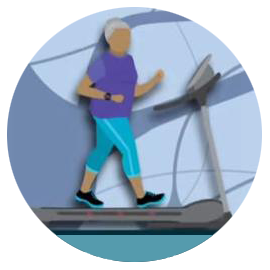Parkinson’s Exercise Recommendations
Exercise and physical activity can improve many motor and non-motor Parkinson’s symptoms
Aerobic Activity

3 days/week for at least 30 minutes per session of continuous or intermittent at moderate to vigorous intensity.
TYPE: Continuous, rhythmic activities such as brisk walking, running, cycling, swimming, aerobics class.
CONSIDERATIONS: Safety concerns due to risks of freezing of gait, low blood pressure, blunted heart rate response. Supervision may be required
Strength Training

2-3 non-consecutive days/week for at least 30 minutes per session of 10-15 reps for major muscle groups; resistance, speed or power focus.
TYPE: Major muscle groups of upper/lower extremities such as using weight machines, resistance bands, light/moderate handheld weights or body weight.
CONSIDERATIONS: Muscle stiffness or postural instability may hinder full range of motion.
Balance, Agility & Multitasking

2-3 days/week with daily integration if possible.
TYPE: Multi-directional stepping, weight shifting, dynamic balance activities, large movements, multitasking such as yoga, tai chi, dance, boxing.
CONSIDERATIONS: Safety concerns with cognitive and balance problems. Hold on to something stable as needed. Supervision may be required.
Stretching

>2-3 days/week with daily most effective.
TYPE: Sustained stretching with deep breathing or dynamic stretching before exercise.
CONSIDERATIONS: May require adaptations for flexed posture, osteoporosis and pain.

Physical Therapist: See a physical therapist specializing in Parkinson’s for full functional evaluation and recommendations.

Safety first: Exercise during on periods, when taking medication. If not safe to exercise on your own, have someone with you.

Exercise Routine: It’s important to modify and progress your exercise routine over time

Schedule: Participate in 150 minutes of moderate-to-vigorous exercise per week.